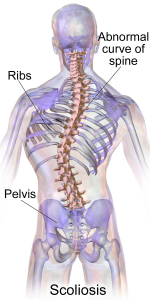Scoliosis
It is natural for the spine to curve forward and backward to a certain degree. This is what gives the side-view of the spine its “S”-like shape. But sometimes the spine twists and develops curves in the wrong direction – sideways. When the spine twists and develops an “S”-shaped curve that goes from side to side, the condition is known as scoliosis (sko-lee-oh-sis).
 Below you can learn about:
Below you can learn about:
What Causes Scoliosis
Symptoms of Scoliosis
Types of Scoliosis
Scoliosis is divided into categories based on the age you are when it is diagnosed:
- Infantile scoliosis is diagnosed before age three
- Juvenile scoliosis is diagnosed from age three to puberty
- Adolescent scoliosis is diagnosed during puberty, usually between the ages of 10 and 15
- Adult scoliosis is diagnosed in adulthood after the spine has stopped growing
- Scoliosis is most commonly seen in adolescents and adults. Adults can also develop scoliosis as a result of bone degeneration.
Adolescent Idiopathic Scoliosis
The word “idiopathic” (id-e-oh-path-ic) means that the cause of this form of scoliosis is unknown. Adolescent idiopathic scoliosis can affect a child who is healthy and not having nerve, muscle or other spine problems. It is the most common form of spinal deformity doctors see, affecting about three percent of the general population.
Adolescent idiopathic scoliosis affects children between 10 and 18 years old, and affects girls more often than boys. In fact, girls are treated 10 times more often than boys. There are many theories as to why this type of scoliosis develops, but the root of the condition has yet to be discovered. Some of the theories include:
- Genetics – scoliosis appears to run in certain families, so it may be hereditary. Significant research is ongoing in the field of genetics.
- Growth – curves progress rapidly during growth spurts, which may mean there is a link between scoliosis and hormones.
- Structural and Biomechanical Changes – some studies have shown that muscle activity increases around the spinal curves. Differences in leg lengths have also been noted in adolescents with idiopathic scoliosis. But there is no clear evidence that this type of change causes scoliosis. It may simply be a secondary result.
- Central Nervous System Changes – because some forms of scoliosis are associated with central nervous system disorders, a lot of research has been focused on this topic. But so far such disorders have not been proven as the root of idiopathic scoliosis.
- Equilibrium and Postural Mechanisms – idiopathic scoliosis could be related to factors that affect how the body is aligned. If a child has problems with posture, balance and body symmetry, it could affect the way the spine is positioned. If the problems are chronic, it may disrupt the way the spine and muscles develop.
A concern when scoliosis is diagnosed in children is that the curves will continue to grow bigger. There is no absolute way to tell, but this much is known:
- Curves in the thoracic spine are more likely to progress than lumbar curves.
- The likelihood of progression is linked to the size of the curve – larger curves are more likely to get bigger
- If the curves start at a young age or before a girl begins her period, they are more likely to progress
- The higher the child’s Risser sign at diagnosis, the less chance there is of progression (the Risser sign is a measure of skeletal maturity. It is based on a 0 to 5 scale, with 5 being full skeletal maturity.)
Adult Scoliosis
Scoliosis that occurs (or is discovered) after puberty is called adult scoliosis. Adult scoliosis can be the result of untreated or unrecognized childhood scoliosis, or it can arise during adulthood. The causes of adult scoliosis are usually different from the childhood types.
Most cases of adult scoliosis are idiopathic because the cause is not known. Sometimes adult scoliosis is the result of changes in the spine due to aging and degeneration. The causes of adult scoliosis are further categorized into several types:
- Idiopathic Curve – usually there is no clear-cut reason why the spine is curved.
- Congenital (con-gen-it-al) Curve – you were born with a curved spine that may not have been recognized or may not have been severe enough to require treatment during childhood. Although it is rare, the scoliosis can get worse later in life due to wear and tear around the abnormal area of the spine.
- Paralytic (par-a lit-ick) Curve – often caused by paralysis from injury to the spinal cord. Paralytic means “the muscles do not work”. When the muscles around the spine are not working, the spine may be thrown out of balance, which can cause an abnormal curvature in the spine.
- Myopathic (my-oh-path-ic) Deformity – like a paralytic curve, “myopathic” also means that the muscles do not work. In this case, the muscles do not work because of a muscular or neuromuscular disease such as muscular dystrophy, cerebral palsy or polio.
- Secondary Scoliosis – developed in adulthood as a result of other spinal conditions that affect the vertebrae, such as degeneration, osteoporosis or osteomalacia (ost-eyo-mal-ace-ia) (softening of the bones). Scoliosis can also appear following spinal surgery for other conditions if the surgery causes an imbalance in the spine.
Degenerative Scoliosis
Degenerative adult scoliosis occurs because of a combination of age and deterioration of the spine. It usually starts after age 40. In older patients, particularly women, it is also often related to osteoporosis. Osteoporosis weakens the bone, making it more likely to deteriorate. The combination of these changes causes the spine to lose its ability to maintain a normal shape. The spine begins to “sag” and as the condition progresses, a scoliotic curve can gradually develop.
Symptoms of Scoliosis
Scoliosis is often painless. People with scoliosis commonly see a spine specialist because they notice a problem with the way their back looks. If you have scoliosis, you may notice some of the following things about your body:
- One shoulder or hip may be higher than the other
- One shoulder blade may be higher and stick out farther than the other
- These deformities are more noticeable when bending over
- A “rib hump” may occur, which is a hump on your back that sticks up when you bend forward. This occurs because the ribs on one side angle more than on the other side
- One arm hangs longer than the other because of a tilt in the upper body
- The waist may appear asymmetrical
Back pain can eventually develop as the condition progresses. The deformity may cause pressure on your nerves and possibly even on your spinal cord. This can lead to weakness, numbness and pain in your lower extremities. In severe cases, pressure on the spinal cord may cause loss of coordination in the muscles of your legs, making it difficult to walk normally. If your chest is deformed due to the scoliosis, your lungs and heart may be affected. This can cause breathing problems, fatigue and even heart failure. Fortunately these severe symptoms are rare.
Degenerative adult scoliosis usually begins as low back pain. While there may also be a deformity that causes the back to look abnormal, usually pain is what motivates people to see their doctor. The pain is probably not coming from the curve, but rather from the degeneration occurring in the spine.
A combination of the degeneration of the spine and scoliosis deformity may cause pressure on nerves and possibly even the spinal cord. This can lead to weakness, numbness, tingling and pain in the lower extremities. In severe cases, pressure on the spinal cord may cause loss of coordination in the muscles of the legs, making it difficult to walk normally. The degeneration and the scoliosis may lead to a condition called spinal stenosis (sten-oh-sis), which is a narrowing of the spinal canal.










